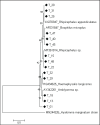Evidence of zoonotic rickettsiae in ixodid ticks of domestic animals in some communal farms in the Eastern Cape Province, South Africa
- PMID: 39101103
- PMCID: PMC11296194
- DOI: 10.5455/javar.2024.k771
Evidence of zoonotic rickettsiae in ixodid ticks of domestic animals in some communal farms in the Eastern Cape Province, South Africa
Abstract
Objective: The abundance of tick populations in South Africa represents a probable risk for both animal and human health. Rickettsia spp. and Borrelia spp. are well-known agents of emerging human tick-borne infectious diseases worldwide. Nevertheless, the epidemiology of their infections has been underreported in South Africa. Therefore, this study aimed to profile zoonotic Rickettsia and Borrelia species from ticks infesting domesticated animals in the Eastern Cape, South Africa.
Materials and methods: Morphological and molecular identification techniques were conducted on 1,200 tick samples collected from domestic animals before screening for the target bacterial pathogens. The molecular identification of the tick samples was based on the amplification of the 12S rRNA mitochondrial Deoxyribonucleic acid. At the same time, those of Rickettsia and Borrelia species were carried out by amplifying fragments of gltA and ompB genes for Rickettsia and flaB gene for Borrelia spp. Thereafter, the positive amplicons for Rickettsia ompB were sequenced and further analyzed. Borrelia PCRs were negative; therefore, sequencing could not be performed.
Results: Eight species of ticks belonging to three genera; Rhipicephalus, Amblyomma, and Haemaphysalis, were identified. A total of 27% (320/1,200) samples were confirmed positive for Rickettsia, of which 23% (74/320) were positive for ompB genes. Phylogenetic analysis of ompB revealed a high homology to rickettsial reference strains from GenBank, with no positive result for Borrelia. The generated sequences showed homology with R. africae-KX227790 (100%), R. parkeri-KY113111 (99.8%), R. peacockii (99.3%), and R. slovaca-JX683122 (99.1%) representative sequences in GenBank.
Conclusion: The findings from this study revealed that ticks harbored Rickettsia species with possible zoonotic potential.
Keywords: Borrelia; Rickettsia; South Africa; domestic animals; emerging; zoonosis.
© The authors.
Conflict of interest statement
None declared by the authors.
Figures




Similar articles
-
Rickettsia africae an Agent of African Tick Bite Fever in Ticks Collected from Domestic Animals in Eastern Cape, South Africa.Pathogens. 2020 Aug 2;9(8):631. doi: 10.3390/pathogens9080631. Pathogens. 2020. PMID: 32748891 Free PMC article.
-
Detection of tick-borne bacterial DNA (Rickettsia sp.) in reptile ticks Amblyomma moreliae from New South Wales, Australia.Parasitol Res. 2024 Jan 9;123(1):89. doi: 10.1007/s00436-023-08108-7. Parasitol Res. 2024. PMID: 38194190 Free PMC article.
-
Genetic diversity of Rickettsia africae isolates from Amblyomma hebraeum and blood from cattle in the Eastern Cape province of South Africa.Exp Appl Acarol. 2020 Dec;82(4):529-541. doi: 10.1007/s10493-020-00555-6. Epub 2020 Oct 6. Exp Appl Acarol. 2020. PMID: 33025239 Free PMC article.
-
First report of spotted fever group Rickettsia aeschlimannii in Hyalomma turanicum, Haemaphysalis bispinosa, and Haemaphysalis montgomeryi infesting domestic animals: updates on the epidemiology of tick-borne Rickettsia aeschlimannii.Front Microbiol. 2023 Dec 15;14:1283814. doi: 10.3389/fmicb.2023.1283814. eCollection 2023. Front Microbiol. 2023. PMID: 38163073 Free PMC article.
-
High Prevalence of Tick-Borne Zoonotic Rickettsia slovaca in Ticks from Wild Boars, Northeastern Italy.Animals (Basel). 2022 Apr 8;12(8):967. doi: 10.3390/ani12080967. Animals (Basel). 2022. PMID: 35454214 Free PMC article.
References
-
- Nicholson WL, Sonenshine DE, Noden BH, Brown RN. Chapter 27 - Ticks (Ixodida) In: Mullen Gary R, Durden Ðance A., editors. Medical and Veterinary Entomology (Third Edition) Academic Press; 2019. pp. 603–72. ISBN 9780128140437; https://doi.org/10.1016/B978-0-12-814043-7.00027-3.
-
- Kahl O. Hard ticks as vectors, some basic issues. Wien klin Wochenschr. 2018;130(15-16):479–83. https://doi.org/10.1007/s00508-018-1360-x. - PubMed
-
- Zhao GP, Wang YX, Fan ZW, Ji Y, Liu M-J, Zhang W-H, et al. Mapping ticks and tick-borne pathogens in China. Nat Commun. 2021;12:1075. https://doi.org/10.1038/s41467-021-21375-1. - PMC - PubMed
-
- Al-Hosary A, Răileanu C, Tauchmann O, Fischer S, Nijhof AM, Silaghi C. Tick species identification and molecular detection of tick-borne pathogens in blood and ticks collected from cattle in Egypt. Ticks Tick Borne Dis. 2021;12:101676. https://doi.org/10.1016/j.ttbdis.2021.101676. - PubMed
-
- Capligina V, Seleznova M, Akopjana S, Freimane L, Lazovska M, Krumins R, et al. Large-scale countrywide screening for tick-borne pathogens in field-collected ticks in Latvia during 2017–2019. Parasit Vectors. 2020;13:351. https://doi.org/10.1186/s13071-020-04219-7. - PMC - PubMed
LinkOut - more resources
Full Text Sources
Miscellaneous
